Delicate flower of hope and inspiration
Donald McClure | Apr 20, 2011 | Comments 5
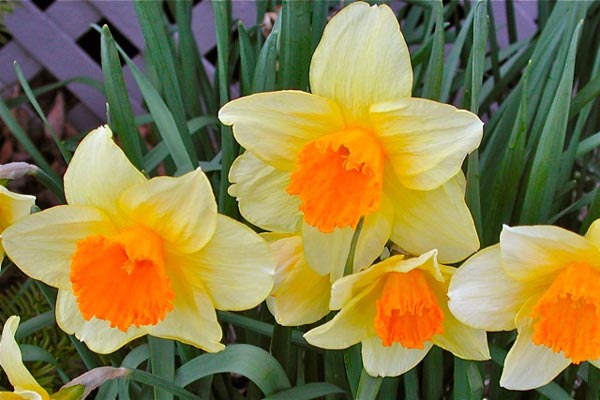
Daffodils have come a long way since we had only yellow-on-yellow. These wide-trumpet types with the light lemon petals are an example of their colour impact on spring. Donald McClure Photo
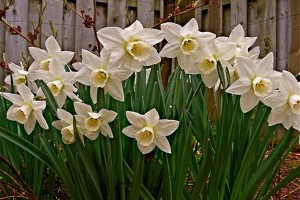
I wandered lonely as a cloud
that floats on high o’er vales and hills
When all at once I saw a crowd,
A host, of golden daffodils’
Beside the lake, beneath the trees,
Fluttering and dancing in the breeze.
-William Wordsworth (1770-1850)
It was a threatening, misty morning – but mild, on 15 April 1802, when William and sister Dorothy Wordsworth went out carrying their lunch to explore a pristine lake in England’s Lake District.
In her diary she records primroses, wood sorrel, anemone, scentless violet and “that starry yellow flower which Mrs C calls pile wort.” When they neared the woods beyond Gowbarrow park they saw a few daffodils close to the water side. Her diary notes that “we fancied that the lake had floated the seeds ashore and that the little colony had so sprung up”. But as they walked along there were more and at last under the boughs of trees, they saw that there was a long display of them along the shore.”
“I never saw daffodils so beautiful,” she writes. “They grew among mossy stones…. some rested their heads upon these stones as on a pillow for weariness and the rest tossed and reeled and danced and seemed as if they verily laughed with the wind that blew upon them over the lake, they looked so gay ever glancing ever changing.”
Brother William wrote his famous daffodil poem two years later and so was born the immortal words — which always come to mind when we think about the flower — particularly if you had to memorize it in the Ontario school system.
Few flowers can stir the emotions like the jaunty daffodil. Drive around the County these days and you will see the perky heads struggling up through the accumulated debris of winter to face the cold reality of this year’s spring.
Emerging into scant sunshine the daffodils, I think, represent a symbol of renewal and a promise of better days to come. Their delicate beauty and form offers an inspirational symbol of hope and comfort.
Obviously Wordsworth was inspired. “And then my heart with pleasure fills, And dances with the daffodils” he wrote to his sister–who needed some uplifting images of her own at the time.
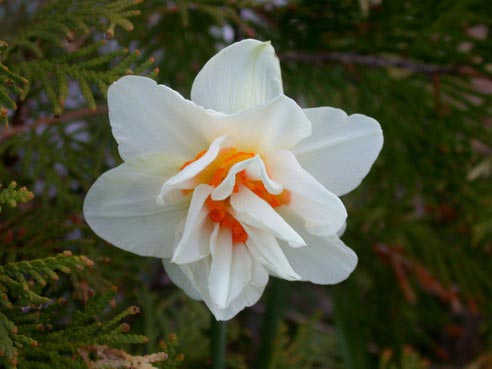
Some daffodils are large and boisterous -- others are small, come in bunches and are extremely fragrant. And some are just downright beautiful like this specimen. Donald McClure Photo
Once I was so fascinated by this flower that I kept a bed of over 500 made up of nearly 50 varieties. I even put together a manual on the subject as a way of identifying the vast number of hybrid types available to the home gardener. But then so many types and varieties came on the market I found it impossible to complete the project.
If you are going to show your daffodils in a major horticultural exhibition these days you are going to be acquainted with 13 horticultural divisions. It wasn’t that long ago there were only nine divisions. What are the differences? They range from Division 1 with a corona length equal to or exceeding the length of the perianth segments and the flowers borne on a stem — up to daffodils with split coronas, flat perianth, bunch flowered, wild…. you get the idea. For such a simple flower it can be a complicated subject.
Other characteristics of these flowers is the toxic nature of the bulbs themselves (and why the squirrels and deer usually leave them alone ). They have folk lore connections dating back into Greek mythology (a symbol of unrequited love), Chinese culture (symbol of a new year, wealth and prosperity). Today in our own culture the flower is used as a symbol of hope by the Canadian Cancer Society.
Bulbs themselves are prolific and offer easy care. If you want your garden to come alive next spring, plan to pick up some fat double bulbs this fall and bring your garden to life Big Time.
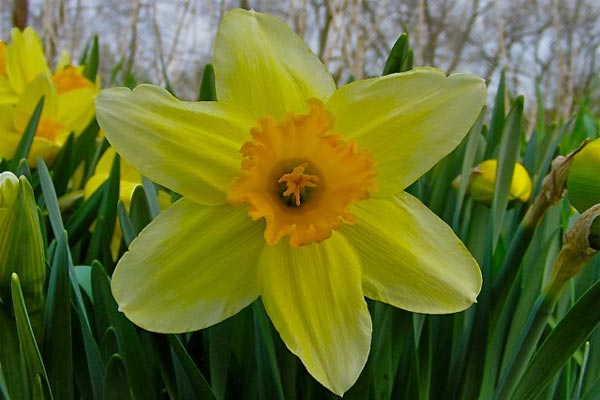
This variety has a fringed, light orange cup to contrast with its ebullient yellow petals. Donald McClure Photo
Filed Under: Donald McClure • Uncategorized
About the Author: He can tickle your funny bone or tug at your heart strings. County people may know him as a chronicler of everything that happens (or should happen) in the garden, but his interests stretch across the natural world. His unique sense of observation takes in a wide expanse of living and may even point out some truths about our own condition as managers of the world around us. With Loyalist antecedents in his family tree his roots go deep into the Ontario countryside.



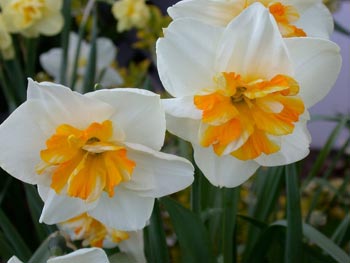




























I wish I could add photos to this space for you…I have a double flowered daffodil at the moment. I realize it is probably just two bulbs that have grown very close together, but it is really weird looking. The stalk is as one, coiling upward and ending in two perfect flower heads.
My garden has shrunk since we moved last September to a nice mobile park on Pleasant Bay. Before this, I had an old house (and before that a farm) with old gardens and then I added more to it! Always perennials, and some shrubs (bridal wreath spiraea!) and herbs. I do miss all that, and maybe that’s why I gravitate to your blog to get my ‘fill’ of gardens. Also, I have come to realize that all the world is a garden made just for us humans. I only need to walk out my door and down the road or across the field and I am surrounded by flora!
Thank you again for your encouragment Louisa. It is always a pleasure to realize that you are bringing some joy to other gardeners. Keep me posted on your progress this season. Would love to hear more about your own garden. Regards
Thank you Dawn. This certainly has been a coolish spring and we have been fortunate to have these tough little plants to give us a a semblance of sunshine in the garden. Good luck in the season ahead.
I didnt realize there are so many different varieties of daffodils! Frost is called for tonight but my daffodils will survive Jack and continue as a reminder to me that spring is really finally here! Lovely article!
Hi Donald – what gorgeous photos! My own daffies have been out for a week now, and with this cool temperature, they certainly won’t ‘melt’ away too quickly. I only have the regular yellow ones at my new home, but at my previous home I had a huge variety, including a salmon-pink one that I was partial to. Daffodils are such a harbinger of spring, aren’t they? Right along with the hyacinths, crocuses and some perennials – my neighbour has bleeding hearts and lungwort out already. I love seeing what you have in your gardens – keep adding here!